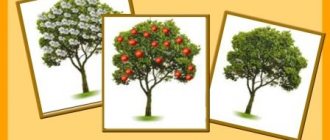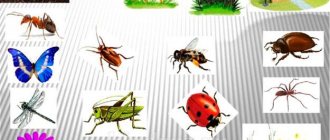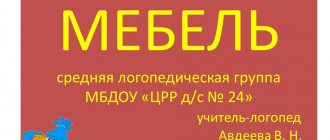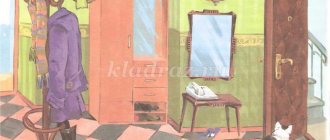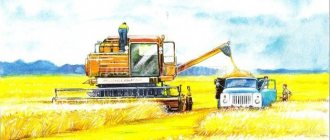Consolidation of knowledge
In order for a child to remember the material well, it is necessary to reinforce it with the help of visual aids. To do this, you can use illustrations on the theme “Red Summer”. First, let the child himself depict the season as he imagines it. The finished drawing needs to be discussed in detail, focusing on the characteristic details.
It is useful to learn a song or several short poems about summer, and then, during the lesson, choose suitable pictures for them. And, of course, riddles that children love so much! For each of them, you need to prepare a card with a clue picture in advance.
Depending on the child's developmental level, you can expand the scope of information using additional tools. It is good, for example, to record the voices of animals and birds on audio media so that the baby learns to recognize them. To develop observation skills, you should teach your child to keep a weather calendar, correctly using symbols.
These simple techniques will help a preschooler firmly grasp the material and turn a serious lesson into an exciting game that the young student will certainly want to repeat.
Diversity of flora
Nature on summer days is distinguished by an abundance of colors and aromas. City parks and squares are decorated with greenery of trees and shrubs. The flower beds are full of colorful decorations: roses, poppies, gladioli, carnations. The fields and meadows are decorated with daisies, buttercups, bells, and cornflowers.
At the beginning of summer, strawberries, cherries, and currants ripen in garden plots. Young potatoes, carrots, and radishes appear in the vegetable beds. A little later, apricots, peaches, and corn will ripen, followed by melons, watermelons, and grapes. Towards the end of the season, you can pick blackberries, lingonberries, cranberries, and rose hips. At the same time, hazelnuts ripen.
Summarizing
At the end of the first – educational – part of the lesson, it is recommended to summarize the material, highlighting the main information from it.
Distinctive characteristics - 15 signs of summer:
- Daytime heat.
- Warm nights.
- Increasing the length of the day.
- High position of the sun.
- Clear blue sky, sometimes with white clouds.
- Warming up reservoirs.
- Showers with thunderstorms.
- The appearance of a rainbow in the sky.
- Formation of morning dew.
- Many stars in the night sky.
- Variety of flowering plants.
- An abundance of berries, fruits and vegetables.
- A large number of insects.
- The chirping of grasshoppers in the evenings.
- Activity of animals and birds.
Wildlife activity
In the summer, forest inhabitants lead an active lifestyle: they set up homes, have offspring, and raise young ones.
- In early June, young gophers emerge from their burrows. Soon they will have to move into separate houses and lead an independent life.
- But the hedgehog is already carefully making a nest. She will have children in July.
- In mid-summer, babies are born to hares and squirrels. Females feed their young with milk.
Interestingly, some animals change color depending on the season. For example, the fur of a brown hare has different shades in summer and winter. His grayish-brown summer coat will become much lighter with the onset of cold weather.
Hot days
The main symptom of summer is heat. The sun is located high above the earth, its rays thoroughly warm everything around, including the soil and water bodies. The days become so hot that the heat remains even at night. The sky turns bright blue. It can be clear or with white clouds like snow.
The daily time period increases. This is observed until June 22, after which the light part of the day will begin to gradually decrease.
Starfall
If you are lucky enough to take a walk with your parents at a late hour, you should definitely look at the night sky. On the eve of a clear sunny day, it is completely covered with stars. In the summer, such bright light flows from them that even without a flashlight, surrounding objects are clearly visible.
Sometimes one or more shooting stars appear in the sky. In fact, these are particles of cosmic bodies, but popularly this phenomenon is called a starfall.
A large number of insects
In summer, gardens, fields and meadows are filled with the multivocal buzzing and rustling of wings. Bumblebees, bees, butterflies, beetles fly, crawl, swarm in flowers, collecting nectar. Leaning over, it’s interesting to watch how the restless ants scurry around. In the grass it is not so easy to notice a green caterpillar, which will soon turn into a pupa, and then a butterfly.
But ladybugs cannot be ignored. The red body with black dots is clearly visible on fresh grass. And, of course, no summer can do without grasshoppers and crickets, which chirp together on warm evenings.
Program content: to develop preschoolers' ideas about seasonal changes in living and inanimate nature during the summer; to form a holistic understanding of the ecological systems of forests, meadows, and reservoirs in the summer season; introduce to the diversity of flora and fauna of the immediate ecological environment; cultivate a culture of behavior in nature in the summer; create a desire to participate in environmental activities; consolidate the ability to measure substances with a conventional yardstick; Exercise children in orientation on a sheet of paper, in the ratio of images of numbers to the number of objects.
Material:
subject pictures of meadow flowers, insects, fish, birds, animals; cards with symbols on the topic “Protect nature!”; ball; clock dial; letter, picture “Summer”; 3 envelopes with tasks.
Progress of the lesson
Educator (V.).
The riddle will help you find out the topic of our lesson:
The sun is burning,
The linden blossoms
The rye is ripening -
When does this happen? (In summer.)
IN.
What signs of summer do you know? (Children's answers.)
Explain the sayings: “In summer dawn meets dawn.” (Long daylight hours.) “In June the sun is high, and from morning to evening it is far away.” Why do they say: in the summer every bush will let you spend the night?
Children.
Because in summer the nights are very warm.
A letter is brought to the group, which says that the image in the picture “Summer” has disappeared. It is necessary to complete all tasks and collect a picture of summer. For each correctly completed task, children will be given a gift - a piece of a picture.
Task No. 1
Aimed at developing logical thinking, attention, and the ability to navigate on a sheet of paper. Children need to draw lines by color and location on the sheet.
The teacher shows a card that shows either a line or a geometric figure. Children should look at the card for a minute and complete it from memory on their sheet. After completion, they receive pictures of the sun and flowers from the teacher as a gift.
IN.
June is “grain growing”. How do you explain this name? (Children's answers.)
IN.
Another name for June is “izok”, in Old Russian - “grasshopper”. This is because one of the signs of June is the loud chirping of grasshoppers. Now guess the riddle:
Snow in summer!
Just laughter.
Snow is flying around the city,
Why doesn't he melt?
Guys, what kind of snow is this?
Children.
This is poplar fluff.
IN.
You're right. This snow is poplar fluff. This is how the poplar spreads its seeds. In summer, many plants bloom. That’s why June is called “multi-colored” in the popular calendar. What do you think are the benefits of flowers?
Children.
Insects feed on their nectar. Many are medicinal.
IN.
Is it possible to collect bouquets in the meadows? Why? What medicinal plants do you know in our fields and meadows? What can be done to prevent adults and children from picking flowers? (Children's answers.)
Practical task. Children come up with prizes, appeals and design signal or warning cards like “Don’t pick the flowers!”
Task No. 2.
Practice measuring bulk solids using a conventional yardstick.
IN.
Measure how many teaspoons and how many tablespoons are in the plate with millet.
There are as many plates as there are children. Half of the children are given teaspoons, half - tablespoons.
After measuring under the guidance of the teacher, the children draw a conclusion: there are more teaspoons of millet, and fewer tablespoons.
IN.
Guys, why are there more teaspoons of millet and fewer tablespoons?
Children.
Because a teaspoon is smaller than a tablespoon, and less millet can fit into it.
IN.
Right. For this you have a gift. (Children are given pictures of a tree with a hollow, bees, birds.)
Listen to how July was called in the popular calendar.
July - "Lipets" - linden blossoms and time for bees. Where do bees live?
Children.
They live in hives, hollows and nests.
IN.
Are these insects beneficial?
Children.
Yes, they collect nectar and make honey - a very useful product for people. And some animals love to eat them.
IN.
What do you need to know when communicating with bees? Is a bee sting dangerous for humans?
Children.
Do not wave your hands, do not catch or kill bees.
IN.
Which literary characters suffered from ignorance of the rules of conduct when meeting bees?
Children.
Winnie the Pooh, a puppy from V. Suteev’s fairy tale “Who said “Meow”?”
IN.
July is the time to hatch the chicks and put them on the wing. Tell us which birds raised their chicks? What are the chicks of these birds called (based on the subject pictures)? What do different birds feed their chicks and how do they teach them to fly? How should you behave if you find a nest with chicks in a forest, meadow or pond? Is it possible to touch them with your hands and feed them? Why? Why can't you make noise in the forest? (Children's answers.)
IN.
In July, hay is harvested. Why do people do this? (Children's answers.) What is the name of the place where the grass is cut?
Children.
Mowing.
IN.
What are the people who cut the grass called?
Children.
Mowers or mowers.
Outdoor game "Mowers".
Task No. 3.
Practice relating the number shown to the number of items brought.
The teacher gives the child a card with a picture of a number.
IN.
Look at the number on your card and bring as many grains as you can.
The children do it. For this, they are given pictures of spikelets and clouds as a gift.
IN.
August - “stubble”, “gustar”, “raznosol”, “serpen”. August raises the bird on his wing: flocks of starlings are the first to noisily make steep takeoffs and turns. In the evenings and in the mornings, gatherings of rooks scream at their nests, and during the day - at their prey. In August, summer runs towards autumn. The bounties of August are countless: people store bread for the whole year, prepare pickles, and obtain food for animals. “Winter has a big mouth, it doesn’t let August sleep.” What exactly do people prepare in August? What preparations do your parents make from berries, fruits and vegetables, mushrooms? What do you need to know and remember when picking berries and mushrooms in the forest? (Children's answers.)
IN.
Guys, what gifts did you receive for completing tasks?
Children.
The sun, flowers, a tree with a hollow, bees, birds, spikelets and clouds.
IN.
Okay, now you need to make a picture of “Summer”.
Children are offered whatman paper with a given background, onto which they need to glue the gifts they receive - team work.
